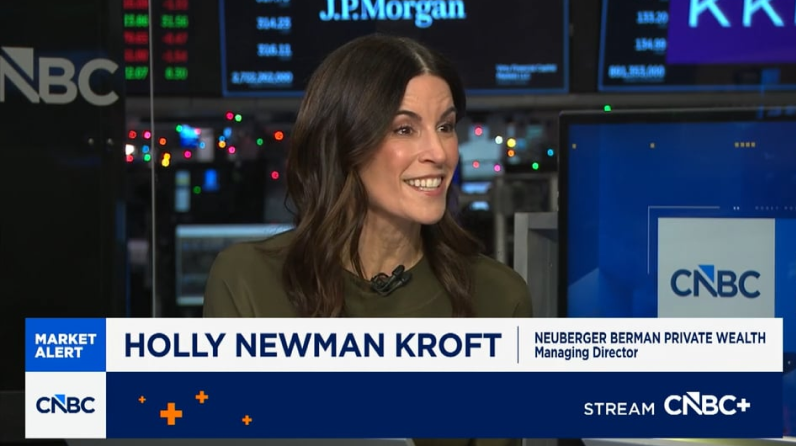

In portfolios, we are looking to position closer to long-term strategic asset allocation targets while considering locking in higher yields at longer maturities and looking to private markets for additional diversification.
In Short
- After seven months of strong equity returns, August saw major asset classes decline across the board with cash being the only safe haven.
- Despite signs of resilience in the face of rising rates, the risk of the government’s increased debt and refinancing coming out of COVID-19 spending may be beginning to materialize.
- August’s lackluster jobs data, alongside rising unemployment and cooling wages, may support a potential September pause in rate hikes.
- In portfolios, we are looking to position closer to long-term strategic asset allocation targets while considering locking in higher yields at longer maturities and looking to private markets for additional diversification.
Summer Swoon, Emerging Risks
After seven months of strong equity returns, August—historically the worst month for the Dow Jones Industrial Average and the second-worst for the S&P 500 Index and Nasdaq over the last 35 years—saw the return of the summer doldrums. The major asset classes were down across the board, with fixed income posting negative returns alongside equities. Cash was the only haven. Unfortunately, when it comes to seasonality, September has historically been the worst month for the market.
However, seasonality is not the sole reason for a lackluster August. As mentioned in our recent note, As Good As It Gets?, Fitch Ratings downgraded U.S. long-term debt from AAA to AA+, citing the fiscal challenges created by COVID-19 stimulus and partisanship during the debt-ceiling negotiations. On the same day, the U.S. Treasury announced an unexpected ramp-up in debt issuance, further signaling the government’s rising borrowing needs and contributing to a sell-off in Treasuries. This pushed up yields, placing additional downward pressure on richly valued U.S. stocks. In a sense, this could be seen as the perfect storm alongside the Federal Reserve (Fed) engaging in quantitative tightening, reducing the purchase of Treasury securities for its balance sheet.
As discussed in a recent CIO Weekly Perspectives, while many have been surprised by the resilience of businesses and households in the face of Fed tightening, the risk of the government’s increased debt and refinancing coming out of massive COVID-19 crisis spending may be beginning to materialize. The pressure on long rates in the Treasury market, with the 10-year yield recently reaching 15-year highs, may further test the resilience to rising rates that we have seen so far in the private sector.
We believe there may be additional risks on the horizon. With more than 200 labor actions so far this year, we have seen a “summer of strikes.” Worker activism sparked by the pandemic seems to be increasing, thanks in part to a still-tight labor market and a relatively strong economy. The next phase of potential strikes could involve the United Auto Workers (UAW), the main union representing organized U.S. auto workers. The union is pushing for a reset of the relationship between Detroit’s automakers and its labor force. In negotiations for a new four-year contract with the Big Three, the UAW is demanding pay raises and the return of benefits that were dropped in the years leading up to the global financial crisis. In terms of potential impact, the automotive industry makes up approximately 3% of U.S. GDP (about 11% of manufacturing). Although only about 10% of U.S. workers are unionized, the outcome of these negotiations could create knock-on effects for the broader economy.
However, the good news is that the labor market has shown signs of cooling this summer, with just 187,000 jobs added in August, following downward revisions in both June and July. Alongside rising unemployment and cooling wages, this could be the final nail in the coffin for a September rate hike. However, the soft-landing narrative that has supported equity prices for much of this year could require that the fine balance delivered in recent employment numbers remain intact for the remainder of 2023.
U.S. Stocks Sold Off as Yields Surged in August

Source: Bloomberg, As of August 31, 2023.
U.S. Debt: Raising the Roof?
Despite the U.S. economy having the strongest recovery from COVID-19-related shutdowns of all G7 nations and a more well-known soft-landing story that is arguably increasingly priced into the market, we believe there may be some medium-to-long term risks to keep in mind—most notably, the rising debt of the federal government. From a historical perspective, U.S. national debt held by the public has grown exponentially over the past five years, increasing 65% to $25.7 trillion in July 2023 (96% of GDP). For context, this compares to an increase of 31% in the five years prior. Total debt is also growing rapidly compared to other developed nations, with a 253% increase since 2007 (see table).
G7 Nations’ Government Debt Profiles

Source: Bloomberg as of July 2023 for Increase in Government Debt. All debt has been measured in USD. Interest rates are based on each country’s respective 10-year yield in nominal term, as of August 2023. Debt-to-GDP is Gross Debt-to-GDP as estimated by the IMF for year ending 2023. Average Interest Rate in Last Decade is measured from 2011 – 2021.
During COVID lockdowns, the federal government put together a generous stimulus package to prop up the U.S. economy. In a significant contractionary event, such as a worldwide pandemic, the government can use spending (or lower taxes) as a lever to help close negative output gaps. It can also do the opposite when it needs to slow the economy, by cutting spending or raising taxes. Though the stimulus package boosted spending and helped support businesses during a challenging time, it cost the U.S. government over $5 trillion from March 2020 – 2022. Emphasizing the unsustainability of the government’s debt problem, the U.S. continues to run a budget deficit, i.e., spending more than revenue received. In 2022, total government spending was $6.27 trillion and total revenue was $4.90 trillion, resulting in a deficit of $1.38 trillion. Servicing its debt is one of the U.S. government’s largest expenses, according to the Congressional Budget Office (CBO). As interest rates rise, this cost will only continue to increase. In fact, the annual cost is projected to more than double over the next 10 years, from an estimated $290 billion in 2021 to $664 billion in 2030.
This issue is clearly not being ignored. The debt ceiling negotiations that took place in late May/early June proved that cuts in government spending will be necessary to slow the growth of U.S. debt held by the public, which the CBO projects to hit 106% of GDP in 2029—matching the historical peak for debt as a percentage of GDP that occurred immediately after World War II.
Note that the debt limit deal includes the following:
- Suspending the cap for two years—now set at $31.4 trillion—to January 1, 2025
- Limiting the growth of federal discretionary spending over the next two years (about 1% of the budget)
However, we must also note that the Trump-era tax breaks established by the Tax Cuts and Jobs Act of 2017 are set to expire at the end of 2025. Assuming the act fully expires, this should generally increase revenues from individual income taxes (52.6% of revenue in 2022).
If the federal debt continues to rise in relation to GDP at the pace of CBO projections, there could be some potential consequences, including increased borrowing costs throughout the economy, elevated risk of a fiscal crisis (investors losing confidence in the U.S. government’s ability to service and repay its debts), and lawmakers feeling constrained in using fiscal policy to respond to unforeseen events.
Despite these challenges, the U.S. economy is still known to be unique in its dynamism and strength. Compared to other world economies, the U.S. is grounded in its rule of law and a vibrant labor market, and continues to be a breeding ground for innovation. It’s a market that cannot be ignored in a global portfolio. Though risks are worth monitoring, both shorter-term like the potential UAW strike, and longer-term, like the mounting U.S. debt, we remain confident in the U.S. economy’s ability to adapt and remain resilient in the face of these challenges.
Historical and Projected U.S. Debt and Budget Deficits

Source: Bloomberg, Congressional Budget Office (CBO), As of August 31, 2023.
Portfolio Implications
Equities were negative across the board in August, with domestic outperforming international on the back of a stronger USD, and small-cap stocks experiencing a larger pullback. We have a market-weight view on equities as part of a general shift to neutralize our positioning by moving clients closer to their long-term strategic asset allocations given ongoing economic uncertainty. Within equities, we still favor lower-beta, higher-quality names with a neutral view on value versus growth. In this more challenging environment, we would also look to active management to select companies with high earnings visibility.
Fixed income was also negative in August, experiencing a reaction to yield increases. We continue to have a favorable view of credit markets, maintaining an overweight view on investment grade securities. While there is still time to capitalize on higher short-term interest rates, clients should consider locking in higher yields at longer maturities to reduce reinvestment risk. We recently downgraded high yield to balance risk in portfolios as well as in view of recent spread-tightening that has reduced the asset class’s risk-adjusted return potential. Meanwhile, emerging markets debt remains an overweight given attractive relative yields and the potential to benefit from stable fundamentals, a more mature monetary cycle, and stimulus in China.
Within private markets, we continue to favor private debt following the emergence of banking system stresses, as tighter financial conditions are beginning to generate opportunities for providers of liquidity. In a challenged fundraising, exit and financing environment, significant opportunities exist for firms and strategies that can act as a liquidity and solutions provider to help close the capital supply/demand gap and support value-add transactions. This backdrop, along with Neuberger Berman’s deep relationships and unique position in the private equity ecosystem, has translated to record levels of deal flow across our platform. As a result, a compelling opportunity set has developed across secondaries, co-investments, private credit and capital solutions.
Index Returns
| Equities & FX | |||
|---|---|---|---|
| Aug-23 | 3Q '23 | YTD 2023 | |
| Major U.S. Indices | |||
| S&P 500 Index | -1.6% | 1.6% | 18.7% |
| Nasdaq Composite | -2.1% | 1.9% | 34.9% |
| Dow Jones | -2.0% | 1.4% | 6.4% |
| U.S. Size Indices | |||
| Large Cap | -1.7% | 1.6% | 18.6% |
| Mid Cap | -3.5% | 0.4% | 9.4% |
| Small Cap | -5.0% | 0.8% | 9.0% |
| All Cap | -1.9% | 1.6% | 18.0% |
| U.S. Style Indices | |||
| Large Cap Growth | -0.9% | 2.4% | 32.2% |
| Large Cap Value | -2.7% | 0.7% | 5.9% |
| Small Cap Growth | -5.2% | -0.8% | 12.7% |
| Small Cap Value | -4.8% | 2.4% | 4.9% |
| Global Equity Indices | |||
| ACWI | -2.8% | 0.8% | 14.8% |
| ACWI ex US | -4.5% | -0.6% | 8.8% |
| DM Non-U.S. Equities | -3.8% | -0.7% | 11.3% |
| EM Equities | -6.1% | -0.2% | 4.9% |
| Portfolios | |||
| 50/50 Portfolio | -1.5% | 0.3% | 10.2% |
| FX | |||
| U.S. Dollar | 1.7% | 0.5% | 0.1% |
| Fixed Income & Commodities | |||
|---|---|---|---|
| Aug-23 | 3Q '23 | YTD 2023 | |
| Major U.S. Indices | |||
| Cash | 0.5% | 0.9% | 3.1% |
| U.S. Aggregate | -0.6% | -0.7% | 1.4% |
| Munis | -1.4% | -1.0% | 1.6% |
| U.S. Munis | |||
| Munis Short Duration | -0.2% | 0.0% | 1.0% |
| Munis Intermediate Duration | -1.1% | -0.7% | 0.9% |
| Munis Long Duration | -2.0% | -1.6% | 2.1% |
| U.S. Corporates | |||
| Investment Grade | -0.8% | -0.4% | 2.8% |
| High Yield | 0.2% | 1.4% | 6.3% |
| Short Duration | 0.4% | 0.8% | 2.0% |
| Long Duration | -2.2% | -3.1% | 0.8% |
| Global Fixed Income Indices | |||
| Global Aggregate | -1.4% | -0.7% | 0.7% |
| EMD Corporates | -0.5% | 0.4% | 3.7% |
| EMD Sovereigns - USD | -1.5% | 0.4% | 4.5% |
| Commodities | |||
| Commodities | -0.8% | 6.5% | -2.8% |
| Commodities ex Energy | -2.2% | 2.8% | -0.5% |
| U.S. Treasury Yields | |||
| U.S. 10-Year Yield | 0.1% | 0.2% | 0.2% |
| U.S. 2-Year Yield | 0.0% | -0.1% | 0.4% |
Source: Bloomberg, total returns as of August 31, 2023. S&P 500 Index is represented by S&P 500 Total Return Index. Nasdaq Composite NASDAQ-Composite Total Return Index. Dow Jones is represented by Dow Jones Industrial Average TR. Large Cap is represented by Russell 1000 Total Return Index. Mid Cap is represented by Russell Midcap Index Total Return. Small Cap is represented by Russell 2000 Total Return Index. All Cap is represented by Russell 3000 Total Return Index. Large Cap Growth is represented by Russell 1000 Growth Total Return. Large Cap Value is represented by Russell 1000 Value Index Total Return. Small Cap Growth is represented by Russell 2000 Growth Total Return. Small Cap Value is represented by Russell 2000 Value Total Return. ACWI is represented by MSCI ACWI Net Total Return USD Index. ACWI ex US is represented by MSCI ACWI ex USA Net Total Return USD Index. DM Non-U.S. Equities is represented by MSCI Daily TR Gross EAFE USD. EM Equities is represented by MSCI Daily TR Gross EM USD. Cash is represented by ICE BofA US 3-Month Treasury Bill Index. U.S. Aggregate is represented by Bloomberg US Agg Total Return Value Unhedged USD. Munis is represented by Bloomberg Municipal Bond Index Total Return Index Value Unhedged USD. Munis Short Duration is represented by Bloomberg Municipal Bond: Muni Short (1-5) Total Return Unhedged USD. Munis Intermediate Duration is represented by Bloomberg Municipal Bond: Muni Intermediate (5-10) TR Unhedged USD. Investment Grade is represented by Bloomberg US Corporate Total Return Value Unhedged USD. High Yield is represented by Bloomberg US High Yield BB/B 2% Issuer Cap Total Return Index Value Unhedged USD. Short Duration is represented by Bloomberg US Agg 1-3 Year Total Return Value Unhedged USD. Long Duration is represented by Bloomberg US Agg 10+ Year Total Return Value Unhedged USD. Global Aggregate is represented by Bloomberg Global-Aggregate Total Return Index Value Unhedged USD. EMD Corporates is represented by J.P. Morgan Corporate EMBI Diversified Composite Index Level. EMD Sovereigns – USD is represented by J.P. Morgan EMBI Global Diversified Composite. Commodities is represented by Bloomberg Commodity Index Total Return. Commodities ex Energy is represented by Bloomberg ExEnergy Subindex Total Return. U.S. 10-Year Yield is represented by US Generic Govt 10 Yr.


MARKET COMMENTARY
Taking Stock of 2025

VIDEO
Holly Newman Kroft Featured on CNBC’s Money Movers December 18

VIDEO
The Kantor Group | Charles Kantor’s Year-End Reflections and Key Questions as We Head Into 2026

INSIGHTS
CIO Notebook: Dual Release of Delayed Non-Farm Payrolls Likely Supports Another Cut

INSIGHTS
Using Tax-Free Gifts for Wealth Transfer

INSIGHTS
CIO Notebook: Powell Plays the Middle as Fed Cuts Rates

MARKET COMMENTARY
Giving Thanks for Market Strength
INSIGHTS
CIO Notebook: September U.S. Non-Farm Payrolls Further Complicate the Narrative
VIDEO
Holly Newman Kroft Featured on CNBC’s Money Movers November 18
VIDEO
Plan for Peace of Mind with Our Estate Planning Organizer
MARKET COMMENTARY
Some Tricks, More Treats
INSIGHTS
CIO Notebook: Markets Rattled as Fed Leans Hawkish
REPLAY
Private Wealth Investment Outlook 4Q25
IMPORTANT INFORMATION:
This material is provided for informational purposes only and nothing herein constitutes investment, legal, accounting or tax advice, or a recommendation to buy, sell or hold a security. This material is general in nature and is not directed to any category of investors and should not be regarded as individualized, a recommendation, investment advice or a suggestion to engage in or refrain from any investment-related course of action. .All information is current as of the date of this material and is subject to change without notice. The firm, its employees and advisory accounts may hold positions of any companies discussed. Any views or opinions expressed may not reflect those of the firm as a whole. Neuberger Berman products and services may not be available in all jurisdictions or to all client types. Diversification does not guarantee profit or protect against loss in declining markets. Investments in private equity are speculative and involve a higher degree of risk than more traditional investments. Investments in private equity are intended for sophisticated investors only. Unless otherwise indicated, returns shown reflect reinvestment of dividends and distributions. Indexes are unmanaged and are not available for direct investment. Investing entails risks, including possible loss of principal. Past performance is no guarantee of future results.
Portfolio positioning views expressed herein are those of Neuberger Berman’s Investment Strategy Group (ISG), which may include those of the Neuberger Berman’s Asset Allocation Committee. Asset allocation and positioning views are based on a hypothetical reference portfolio. ISG analyzes market and economic indicators to develop asset allocation strategies. ISG works in partnership with the Office of the CIO. ISG also consults regularly with portfolio managers and investment officers across the firm. The Asset Allocation Committee is comprised of professionals across multiple disciplines, including equity and fixed income strategists and portfolio managers. The Asset Allocation Committee reviews and sets long-term asset allocation models, establishes preferred near-term tactical asset class allocations and, upon request, reviews asset allocations for large diversified mandates. Asset Allocation Committee members are polled on asset classes and the positional views are representative of an Asset Allocation Committee consensus. The views of the Asset Allocation Committee and ISG may not reflect the views of the firm as a whole and Neuberger Berman advisers and portfolio managers may take contrary positions to the views of the Asset Allocation Committee or ISG. The Asset Allocation Committee and ISG views do not constitute a prediction or projection of future events or future market behavior. Defensive positioning generally means an underweight bias on allocations to risk assets such as equities and alternatives. Positioning views may change over time without notice and actual client positioning may vary significantly. Discussion of yield characteristics or total returns of different asset classes are for illustrative purposes only. Such asset classes, such as equities and fixed income, may have significantly different overall risk-return characteristics which should be consider before investing.
The information in this material may contain projections, market outlooks or other forward-looking statements regarding future events, including economic, asset class and market outlooks or expectations, and is only current as of the date indicated. There is no assurance that such events, outlook and expectations will be achieved, and actual results may be significantly different than that shown here. The duration and characteristics of past market/economic cycles and market behavior, including any bull/bear markets, is no indication of the duration and characteristics of any current or future be market/economic cycles or behavior. Information on historical observations about asset or sub-asset classes is not intended to represent or predict future events. Historical trends do not imply, forecast or guarantee future results. Information is based on current views and market conditions, which will fluctuate and may be superseded by subsequent market events or for other reasons.
Discussions of any specific sectors and companies are for informational purposes only. This material is not intended as a formal research report and should not be relied upon as a basis for making an investment decision. The firm, its employees and advisory accounts may hold positions of any companies discussed. Nothing herein constitutes a recommendation to buy, sell or hold a security. It should not be assumed that any investments in securities, companies, sectors or markets identified and described were or will be profitable. Investment decisions and the appropriateness of this content should be made based on an investor's individual objectives and circumstances and in consultation with his or her advisors.
Neuberger Berman Investment Advisers LLC is a registered investment adviser.
The “Neuberger Berman” name and logo are registered service marks of Neuberger Berman Group LLC.